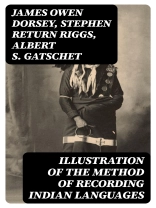In ‘Illustration of the Method of Recording Indian Languages, ‘ a groundbreaking anthology, readers are presented with an exemplary collection that dives deep into the methodologies of documenting Native American languages. This anthology stands as a monumental work, demonstrating the varied literary styles and methodologies undertaken by early ethnographers and linguists. It reflects a critical period in the understanding and preservation of Native American languages, showcasing the significant efforts of the contributors to capture the complexity and richness of these languages within the limits of the written word. The anthology features standout pieces that exemplify the painstaking efforts to record and analyze languages that were, at the time, primarily oral and at risk of being lost. The collection, therefore, not only serves as a linguistic treasure but also as an invaluable anthropological resource, reflecting the depth and diversity of the Native American linguistic landscape. The contributing authors, James Owen Dorsey, Stephen Return Riggs, and Albert S. Gatschet, are each renowned for their extensive work among Native American communities and for their pioneering contributions to ethnography and linguistics. These scholars were part of a larger, critically important movement in the 19th and early 20th centuries that sought to preserve endangered languages and cultures. By bringing together their works, this anthology underscores the collective importance of their methodologies, while highlighting the historical and cultural contexts of the time. Each author’s unique approach and dedication to their subject matter enrich the anthology, offering readers a comprehensive understanding of the complexity and diversity of Native American languages and the challenges involved in their study and preservation. This anthology is recommended for anyone with an interest in linguistics, anthropology, or Native American studies. ‘Illustration of the Method of Recording Indian Languages’ provides a unique opportunity to explore the rich tapestry of Native American languages through the eyes of three pioneering scholars. The collection serves not only as an educational resource but also as a tribute to the languages and cultures that these scholars sought to preserve. It encourages a deeper dialogue between past and present studies, offering insights into the evolution of linguistic research and the enduring significance of preserving linguistic diversity.
关于作者
James Owen Dorsey (1848-1895) was an esteemed American ethnologist, linguist, and missionary known for his significant contributions to the study of Native American languages and cultures. Born in Baltimore, Maryland, Dorsey developed an interest in native cultures at an early age. Despite his initial religious endeavors, his true passion lay in the study of indigenous languages, an interest that later defined his scholarly pursuit. Dorsey’s work with the Bureau of American Ethnology from 1880 until his death solidified his reputation as a meticulous linguist and ethnographer. His influential publication, ‘Illustration of the Method of Recording Indian Languages, ‘ is a testament to his dedication to the systematic documentation and preservation of Native American linguistic data. Dorsey’s approach was characterized by a combination of fieldwork and analytical study, seeking not only to record languages but also to understand their underlying structures and cultural contexts. His literary style, marked by precision and clarity, aimed to provide a comprehensive and accessible guide for future researchers. Dorsey’s legacy extends beyond his written works, as his methodological contributions continue to impact the way scholars engage with indigenous languages and cultures. His remarkable dedication to this specialized field has earned him a place among the prominent figures in the history of American ethnology and linguistics.












